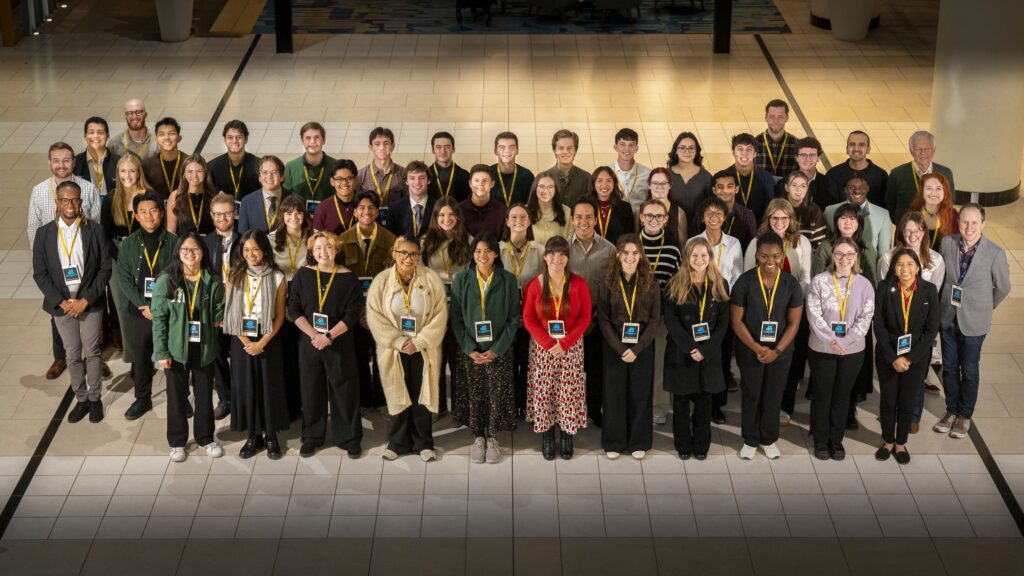In 1995, the Drum Corps International World Championships returned to the site of the 1990 season-ending events, the now renamed Ralph Wilson Stadium near Buffalo, New York.
Among 1995’s most memorable moments was Carolina Crown’s first trip to the Finals, Colts members achieving their highest DCI placement, and the Glassmen marking 10 years in a row of higher placements than the year before.
Blue Devils’ “Carpe Noctem” and Santa Clara Vanguard’s “Not the Nutcracker” challenged drum corps fans with shows that were more esoteric than usual, while Madison Scouts’ bullfighting-inspired production brought crowds to their feet.
The Cavaliers won their second DCI World Championship title (the first came in 1992) with Gustav Holst’s “The Planets.” This was 10 years after riding music from the same orchestral suite to the corps’ first finish in the top half of the top-12 finalists in 1985.
It wasn’t exactly a finish fans expected throughout the season: Earlier, the Cavaliers lost numerous shows to the eventual second-, third- and fourth-place corps, losing to the Madison Scouts as many as seven times. Yet, when the World Championships rolled around, the Green Machine opened up the spread over the second-place corps from two tenths of a point in the Prelims to eight tenths in the Semifinals and more than a point in the Finals.
British composer Gustav Holst wrote his seven-movement orchestral suite in 1914-1916, shortly after the premier of Stravinsky’s “The Rite of Spring.” He approached each movement of the suite as conveying the emotions of the planets in an astrological sense.
Originally “The Planets” was scored for two pianos, except for “Neptune,” which was scored for organ. The work became Holst’s best-known creation, but the composer never regarded it as one of his best compositions.
The orchestral rendition was premiered on short notice in 1918 toward the very end of World War I. Conductor Adrian Boult said this was because Holst was about to leave for an extended visit to Greece. A good friend had just paid for the use of a major London concert hall for the premiere, complete with full orchestra. So hasty was the production, the orchestra members didn’t see the music until two hours prior to the performance.
The Cavaliers’ 1995 production was so totally different from their 1985 effort that it’s not accurate to say the show was reworked. Since 1985, many new staff members came on board and helped lift the corps into the upper pantheon of DCI finalists. Three of the four movements remained the same, with “Uranus” replaced by “Venus.” The four movements performed by the corps followed the exact same order as the first four movements of Holst’s suite.
The Roman God of war, for whom the month of March is named, inspired the intense barbarity of “Mars the Bringer of War.” The Cavaliers began as the suite does, with the incessant 5/4 time-signature repetitive rhythmic figure that inspired John Williams’ “Imperial March” from “Star Wars.”
As Mars is known as “The Red Planet,” snare drums were red and the color guard flags featured vertical strips of shades of orange and red. The piece was especially barbaric, leading to a block circle of brass players that with internal movement made the entire circle appear to be rotating.
“Venus, the Bringer of Peace” was named after the Roman goddess of love and sexuality whose characterization evolved out of the Greek goddess, Aphrodite. The movement’s ethereal nature was about as contrary in mood to “Mars” as possible.
During this section a number of open planetary orbs were seen across the field, twirled by members of the color guard. Facing backfield, the horns manipulated a four-deep block form by gently moving it back and forth, while at the same time the columns gently expanded and contracted. The serene visual effect was like looking at heat waves rising above a distant horizon.
Holst based “Mercury, the Winged Messenger” on the Roman god of commerce, poetry, and communication. The work was essentially a percussion feature with some brass contributions, culminating with the corps pulling off what would become one of its best-known drill formations of all-time, a rotating DNA helix.
The final four and a half minutes of the show focused on “Jupiter, the Bringer of Jollity,” the most popular piece in the suite and one used often in popular culture. A major portion of the movement was the chorale that Holst adapted into the hymn, “I Vow to Thee, My Country,” which became quite popular in Great Britain and regarded as a popular patriotic anthem.
The chorale was mostly played backfield, allowing the brass players to create a sort of organ-like effect via the sound bouncing off the back stands. Things culminated in a grand final statement, with a lone color guard member climbing a tall pole and hoisting up one of the miniature open planetary orbs utilized during the last part of “Mercury.”
A series of quick geometric evolutions led into a reprisal of the “rotating planet” block circle routine from the end of “Mars,” enhanced by a piercing return of the “Mars” rhythmic figure.
1995 Overview

Michael Boo was a member of the Cavaliers from 1975-1977. He wrote about the drum corps activity for more than 35 years while serving as a staff writer for various Drum Corps International projects. During his lifetime Boo wrote for numerous other publications including an honors-winning book on the history of figure skating. He also was an accomplished composer. Boo passed away in 2020 and was inducted into the DCI Hall of Fame posthumously in 2021.





